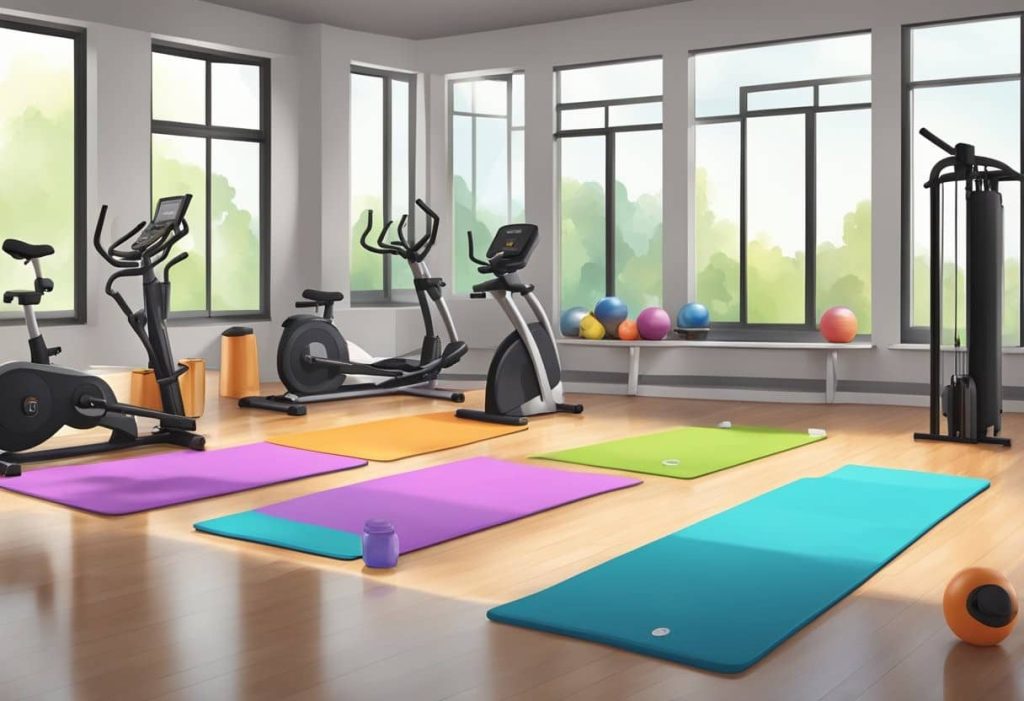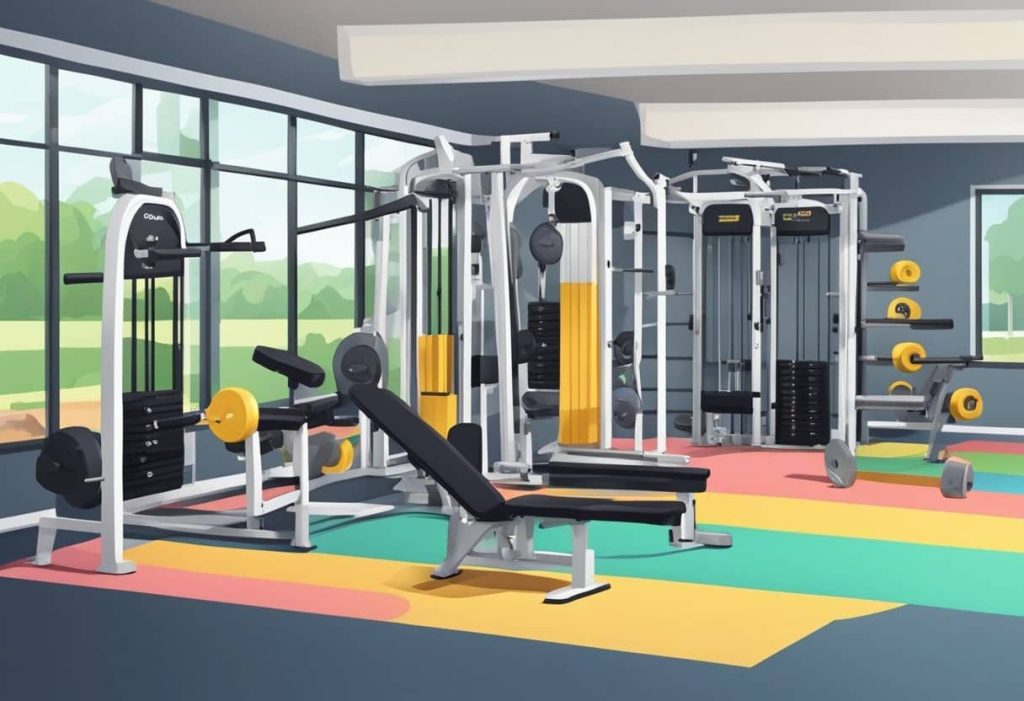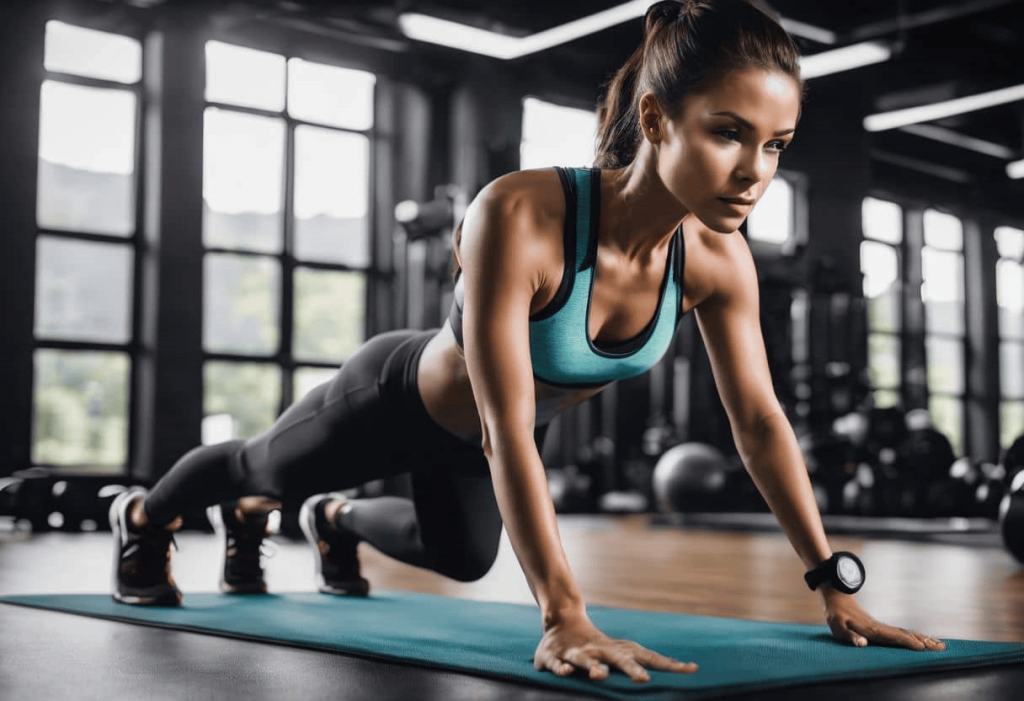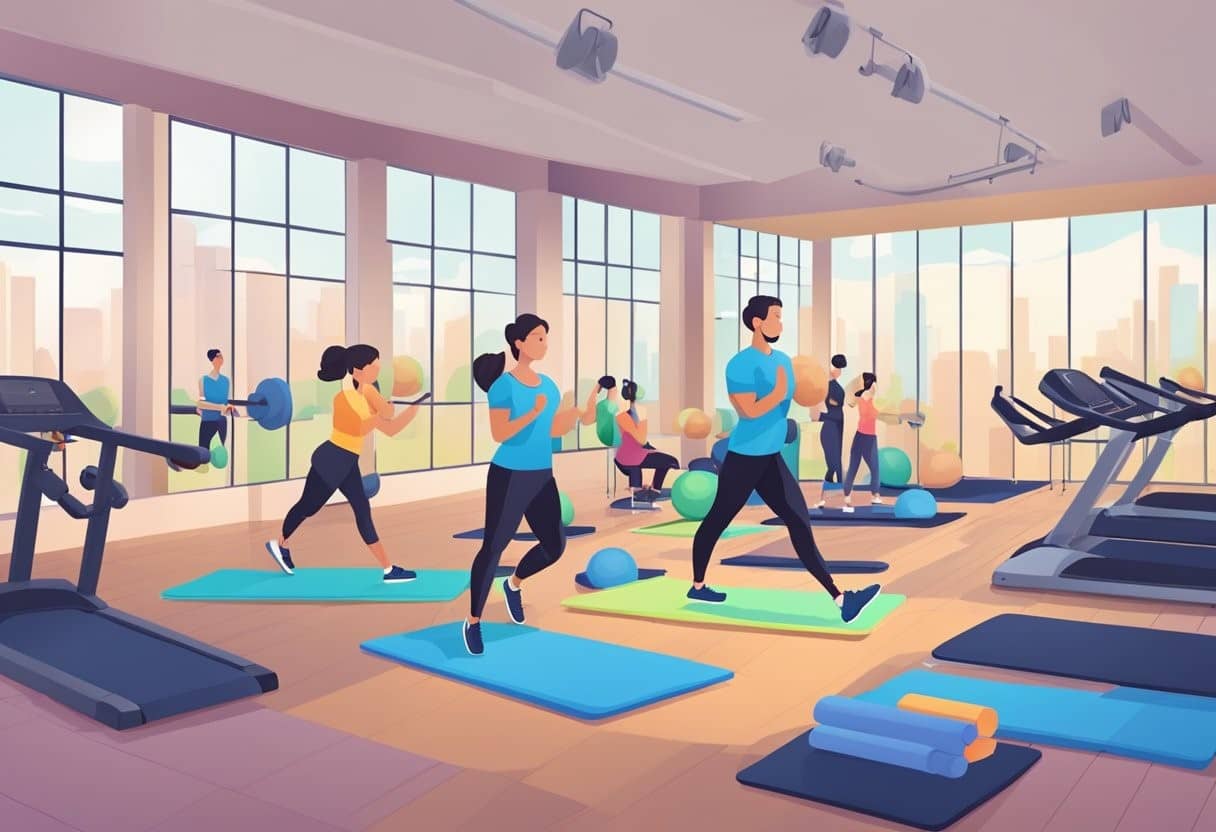Regular physical activity is essential for maintaining good health and fitness. Exercise can help prevent chronic diseases, improve mental health, and reduce the risk of premature death. However, many people struggle to incorporate exercise into their daily routines. This article will provide tips and guidelines for staying fit and healthy with exercise and physical activity.
Understanding fitness and health is the first step towards creating a healthy lifestyle. Fitness refers to the ability to perform physical activities, while health refers to the overall well-being of the body. Both fitness and health are important for maintaining a good quality of life. Exercise and physical activity are key components of a healthy lifestyle and can help improve both fitness and health.
The importance of staying fit cannot be overstated. Regular exercise can help prevent chronic diseases such as heart disease, diabetes, and obesity. It can also improve mental health by reducing symptoms of anxiety and depression. In addition, exercise can improve sleep quality, boost energy levels, and increase overall feelings of well-being. By incorporating exercise into daily routines, individuals can improve their fitness and health and enjoy a better quality of life.
Key Takeaways
- Regular physical activity is essential for maintaining good health and fitness.
- Exercise can help prevent chronic diseases, improve mental health, and reduce the risk of premature death.
- By incorporating exercise into daily routines, individuals can improve their fitness and health and enjoy a better quality of life.
Understanding Fitness and Health

Fitness and health are two concepts that are closely related to each other. Fitness refers to the ability of the body to perform physical activities, while health refers to the overall well-being of an individual. Being fit means having a healthy body that can perform physical activities with ease.
Physical activity is an essential component of fitness and health. Regular exercise can help improve overall health and reduce the risk of chronic diseases. Exercise can also help maintain a healthy weight, improve cardiovascular health, and boost mental health.
There are different types of physical activities that can help improve fitness and health. Aerobic exercise, such as running, swimming, or cycling, can help improve cardiovascular health and endurance. Strength training, such as weightlifting, can help build muscle mass and improve bone density. Flexibility exercises, such as yoga or stretching, can help improve mobility and reduce the risk of injury.
In addition to physical activity, nutrition is also an important aspect of fitness and health. A balanced diet that includes a variety of fruits, vegetables, whole grains, lean proteins, and healthy fats can help provide the body with the necessary nutrients to perform physical activities and maintain overall health.
It is important to note that fitness and health are not one-size-fits-all. What works for one person may not work for another. It is important to consult with a healthcare professional before starting any new exercise or diet program.
Overall, understanding the relationship between fitness and health can help individuals make informed decisions about their lifestyle choices. Incorporating regular physical activity and a balanced diet can help improve fitness and overall health.
The Importance of Staying Fit

Physical activity and exercise are essential for maintaining good health and preventing chronic diseases. Regular exercise can help improve cardiovascular health, strengthen bones and muscles, and reduce the risk of obesity, diabetes, and certain cancers.
Staying fit and active can also improve mental health, reduce stress and anxiety, and enhance overall well-being. Exercise releases endorphins, which are natural mood boosters, and can help individuals feel more energized and focused throughout the day.
It is important to note that staying fit does not necessarily mean spending hours at the gym every day. Simple lifestyle changes, such as taking the stairs instead of the elevator, walking or biking to work, or incorporating physical activity into daily routines, can also have a significant impact on overall health and fitness.
Individuals should aim for at least 150 minutes of moderate-intensity aerobic exercise per week, in addition to muscle-strengthening activities at least two days per week. This can include activities such as brisk walking, swimming, cycling, or weightlifting.
In addition to physical activity, maintaining a healthy diet and getting enough sleep are also crucial for staying fit and healthy. Eating a balanced diet that is rich in fruits, vegetables, whole grains, and lean protein can help provide the nutrients and energy needed for physical activity, while also reducing the risk of chronic diseases.
Overall, staying fit and active is an important aspect of maintaining good health and well-being. By incorporating physical activity into daily routines and making healthy lifestyle choices, individuals can improve their physical and mental health, reduce the risk of chronic diseases, and enhance overall quality of life.
Exercise and Its Role in Health

Regular exercise is essential for maintaining good health. Exercise can help control weight, reduce the risk of chronic diseases, and improve mental health. The Mayo Clinic lists seven benefits of regular physical activity, including controlling weight, reducing the risk of heart disease, improving mood, and increasing energy levels.
Physical activity can include a wide range of activities, from walking and running to weightlifting and yoga. The American Heart Association recommends at least 150 minutes of moderate-intensity aerobic exercise or 75 minutes of vigorous-intensity aerobic exercise per week for adults. Additionally, adults should engage in muscle-strengthening activities at least two days per week.
Exercise can help control weight by burning calories. The more intense the activity, the more calories burned. Regular exercise can also help prevent excess weight gain and maintain weight loss. Additionally, exercise can help improve muscle mass and bone density, which can help prevent osteoporosis.
Exercise can also reduce the risk of chronic diseases, including heart disease, stroke, diabetes, and certain types of cancer. Regular physical activity can help lower blood pressure, improve cholesterol levels, and reduce inflammation in the body.
In addition to physical health benefits, exercise can also improve mental health. Exercise has been shown to reduce symptoms of depression and anxiety, improve mood, and increase self-esteem. Exercise can also improve cognitive function and reduce the risk of cognitive decline in older adults.
Overall, exercise plays a crucial role in maintaining good health. By engaging in regular physical activity, individuals can control weight, reduce the risk of chronic diseases, and improve mental health.
Benefits of Regular Physical Activity

Regular physical activity has numerous benefits for overall health and well-being. According to the CDC, being physically active can help manage weight, reduce the risk of chronic diseases, improve brain health, strengthen bones and muscles, and improve the ability to do everyday activities.
One of the most significant benefits of physical activity is weight management. When individuals take part in physical activity, they burn calories, which can help prevent excess weight gain or help keep off lost weight. The more intense the activity, the more calories they burn.
Physical activity can also reduce the risk of chronic diseases such as heart disease, stroke, type 2 diabetes, and some types of cancer. It can also help manage existing health conditions such as high blood pressure and high cholesterol.
Another benefit of physical activity is improved brain function. Exercise increases heart rate, which promotes blood flow and oxygen to the brain. This can protect memory and thinking skills and reduce the risk of cognitive decline in older adults.
Physical activity also strengthens bones and muscles, reducing the risk of falls and fractures. It can improve balance and coordination, making it easier to perform everyday activities such as walking up stairs or carrying groceries.
Lastly, physical activity can improve overall quality of life by reducing stress and anxiety, improving mood, and promoting better sleep. It can also increase energy levels, allowing individuals to be more productive and get more done throughout the day.
Overall, regular physical activity has numerous benefits for overall health and well-being. Incorporating physical activity into daily routines can help manage weight, reduce the risk of chronic diseases, improve brain health, strengthen bones and muscles, and improve overall quality of life.
Creating Your Exercise Routines

When it comes to creating an exercise routine, there are a few key factors to consider. First, it’s important to determine your fitness goals. Do you want to lose weight? Build muscle? Improve your cardiovascular health? Once you know what you want to achieve, you can tailor your exercise routine to meet those goals.
Next, consider your fitness level. If you’re just starting out, it’s important to start slow and gradually increase the intensity and duration of your workouts. This will help prevent injury and ensure that you’re able to stick with your exercise routine over the long term.
When creating your exercise routine, it’s important to include a variety of exercises that target different muscle groups. This will help ensure that you’re getting a full-body workout and will help prevent boredom. Some exercises to consider include:
- Cardiovascular exercises, such as running, cycling, or swimming
- Strength training exercises, such as weight lifting or bodyweight exercises
- Flexibility exercises, such as yoga or stretching
It’s also important to consider the frequency and duration of your workouts. The American Heart Association recommends at least 150 minutes of moderate-intensity aerobic exercise or 75 minutes of vigorous aerobic exercise per week, spread out over at least three days. Strength training exercises should be done at least two days per week, targeting all major muscle groups.
Finally, don’t forget to warm up before each workout and cool down afterwards. This will help prevent injury and ensure that your body is properly prepared for exercise.
Overall, creating an exercise routine requires careful consideration of your fitness goals, fitness level, and the types of exercises that will help you achieve those goals. By taking the time to create a well-rounded exercise routine, you can improve your overall health and fitness and enjoy the many benefits of regular exercise.
Maintaining Healthy Exercise Habits

Regular exercise is essential for maintaining a healthy body and mind. However, it can be challenging to keep up with an exercise routine, especially with a busy schedule. Here are some tips for maintaining healthy exercise habits:
Set Realistic Goals
Setting realistic goals is crucial for staying motivated and on track. Start small and gradually increase the intensity and duration of your workouts. For example, if you are new to exercise, start with a 10-minute walk around the block and gradually increase the time and distance.
Mix It Up
Variety is the spice of life, and it is also essential for maintaining a healthy exercise routine. Mixing up your workouts can prevent boredom and help you avoid hitting a plateau. Try different types of exercises, such as weightlifting, yoga, or swimming, to keep your routine fresh and exciting.
Find a Workout Buddy
Working out with a friend or family member can be a great way to stay motivated and accountable. Having a workout buddy can also make exercising more fun and enjoyable. You can encourage each other and celebrate each other’s successes.
Make It a Habit
Making exercise a habit is essential for maintaining a healthy lifestyle. Schedule your workouts like you would any other appointment and stick to them. Consistency is key when it comes to exercise, and making it a habit can help ensure that you stay on track.
Listen to Your Body
Listening to your body is crucial for avoiding injury and burnout. If you feel tired or sore, take a rest day or do a lighter workout. Pushing yourself too hard can lead to injury and make it harder to maintain a healthy exercise routine in the long run.
By following these healthy exercise habits, you can maintain a consistent workout routine and achieve your fitness goals.
Guidelines for Physical Fitness

Maintaining physical fitness is essential for overall health and well-being. The following guidelines provide a framework for achieving and maintaining physical fitness:
Aerobic Exercise
Aerobic exercise is any activity that increases heart rate and breathing rate. The World Health Organization (WHO) recommends at least 150 minutes of moderate-intensity aerobic exercise or 75 minutes of vigorous-intensity aerobic exercise per week for adults. This can be achieved through activities such as brisk walking, jogging, cycling, or swimming.
Strength Training
Strength training is an important component of physical fitness, as it helps to build and maintain muscle mass and bone density. The American College of Sports Medicine (ACSM) recommends strength training exercises for all major muscle groups at least two days per week.
Flexibility Training
Flexibility training helps to improve range of motion and prevent injury. The ACSM recommends stretching exercises for all major muscle groups at least two days per week.
Balance Training
Balance training is important for maintaining stability and preventing falls, especially in older adults. The National Institute on Aging recommends balance training exercises at least three days per week for older adults.
Other Considerations
In addition to the above guidelines, it is important to consider other factors that can affect physical fitness, such as nutrition, hydration, and sleep. Eating a balanced diet, staying hydrated, and getting enough sleep are all important for maintaining physical fitness.
Overall, following these guidelines can help individuals achieve and maintain physical fitness, leading to improved health and well-being.
Tips for a Healthy Lifestyle

Maintaining a healthy lifestyle is essential for overall well-being. A healthy lifestyle involves a combination of healthy eating habits, regular exercise, and proper sleep. Here are some tips to help you maintain a healthy lifestyle:
1. Regular Exercise
Regular exercise is essential for maintaining a healthy lifestyle. It helps to improve cardiovascular health, maintain a healthy weight, and reduce the risk of chronic diseases. One should aim for at least 150 minutes of moderate-intensity exercise or 75 minutes of vigorous-intensity exercise per week. It is also important to include strength training exercises at least two days per week.
2. Healthy Eating Habits
A healthy diet is essential for maintaining a healthy lifestyle. One should aim to include a variety of fruits, vegetables, whole grains, lean proteins, and healthy fats in their diet. It is also important to limit the intake of processed foods, sugary drinks, and saturated fats.
3. Proper Sleep
Getting adequate sleep is essential for maintaining a healthy lifestyle. Adults should aim for at least 7-9 hours of sleep per night. Proper sleep helps to improve cognitive function, mood, and overall health.
4. Stress Management
Chronic stress can have a negative impact on overall health. It is important to practice stress management techniques such as deep breathing, meditation, or yoga to reduce stress levels.
5. Avoiding Harmful Habits
Avoiding harmful habits such as smoking and excessive alcohol consumption is essential for maintaining a healthy lifestyle. Smoking can lead to lung cancer, heart disease, and other chronic diseases. Excessive alcohol consumption can lead to liver disease, high blood pressure, and other health problems.
By following these tips, one can maintain a healthy lifestyle and improve overall well-being.
The Connection Between Fitness, Exercise, and Health

Physical fitness and exercise are essential components of a healthy lifestyle. Exercise and physical activity can help maintain a healthy weight, reduce the risk of chronic diseases, improve mental health, and increase overall well-being.
Fitness and Health:
Fitness and health are closely related. Fitness is the ability to perform physical activity and exercise with ease, while health is a state of complete physical, mental, and social well-being. Physical fitness is an important aspect of overall health, and regular exercise can help maintain fitness levels.
Exercise and Health:
Regular exercise has many health benefits. It can reduce the risk of chronic diseases such as heart disease, diabetes, and obesity. Exercise can also improve mental health by reducing symptoms of anxiety and depression. Additionally, exercise can improve overall quality of life by increasing energy levels, improving sleep, and reducing stress.
Types of Exercise:
There are many different types of exercise that can improve fitness and health. Aerobic exercise, such as running, swimming, or cycling, can improve cardiovascular health and endurance. Resistance training, such as weightlifting or bodyweight exercises, can improve strength and muscle mass. Flexibility exercises, such as stretching or yoga, can improve range of motion and prevent injury.
Frequency and Duration of Exercise:
The American Heart Association recommends at least 150 minutes of moderate-intensity aerobic exercise or 75 minutes of vigorous-intensity aerobic exercise per week. Additionally, strength training exercises should be performed at least two days per week. It is important to spread out exercise throughout the week and to gradually increase intensity and duration to prevent injury.
Final Thought:
In conclusion, physical fitness and exercise are essential components of a healthy lifestyle. Regular exercise can improve fitness and health, reduce the risk of chronic diseases, improve mental health, and increase overall well-being. It is important to engage in a variety of types of exercise and to gradually increase intensity and duration to maintain fitness levels.
Final Thoughts
Engaging in regular physical activity is crucial for maintaining good health and well-being. Physical benefits of exercise include reduced risk for diseases, improvements in physical functioning, fitness, and overall quality of life. Muscle-strengthening activities should be performed on two or more days per week.
Assessing physical activity and fitness progression can be done using a variety of measures, such as intensity level, heart rate, perceived exertion, energy cost, and daily step count. Exercise can help control appetite, boost mood, and improve sleep in the short term. In the long term, it reduces the risk of heart disease, stroke, diabetes, dementia, depression, and many cancers.
It is important to note that exercise alone cannot guarantee good health. A balanced diet, adequate sleep, and stress management are also essential components of a healthy lifestyle. Incorporating physical activity into daily routines, such as taking the stairs instead of the elevator, can help increase overall activity levels.
Overall, staying fit and healthy requires dedication and commitment to regular physical activity and a healthy lifestyle. With the right mindset and habits, anyone can achieve their fitness goals and enjoy the benefits of a healthy lifestyle.
Frequently Asked Questions

What are some effective exercises to stay fit and healthy without going to the gym?
There are many exercises that can help you stay fit and healthy without going to the gym. Some examples include:
- Walking or jogging outside
- Cycling
- Swimming
- Yoga or Pilates
- Body weight exercises like push-ups, squats, and lunges
What are some simple ways to keep your body fit and strong?
Keeping your body fit and strong doesn’t have to be complicated. Here are some simple ways to achieve this:
- Incorporate physical activity into your daily routine, such as taking the stairs instead of the elevator or walking to work.
- Eat a balanced diet that includes plenty of fruits, vegetables, and lean protein.
- Stay hydrated by drinking plenty of water throughout the day.
- Get enough sleep each night to allow your body to recover and repair.
What are some tips for staying fit and healthy as a woman?
Women have unique health needs that should be taken into consideration when trying to stay fit and healthy. Here are some tips for women:
- Incorporate weight-bearing exercises into your routine to help maintain bone density.
- Practice pelvic floor exercises to help prevent incontinence and other pelvic floor disorders.
- Get regular screenings for breast and cervical cancer.
- Consider hormonal birth control options that may help regulate menstrual cycles and reduce the risk of certain cancers.
What are some of the best exercises for staying fit and healthy?
The best exercises for staying fit and healthy will depend on your individual goals and preferences. However, some exercises that are generally considered to be effective include:
- Cardiovascular exercises like running, cycling, or swimming to improve heart health and endurance.
- Strength training exercises like weight lifting to build muscle and improve bone density.
- Flexibility exercises like yoga or Pilates to improve range of motion and prevent injury.
What are some easy ways to stay healthy and fit at home?
Staying healthy and fit at home is possible with a little creativity. Here are some easy ways to do so:
- Follow along with online workout videos or apps.
- Use household items like water bottles or cans as weights for strength training exercises.
- Take breaks throughout the day to stretch or do a quick workout.
- Cook healthy meals at home using fresh ingredients.
What are some ways to get fit in a week?
While it’s not realistic to expect significant changes in just one week, there are some things you can do to jump start your fitness journey. Here are some ideas:
- Incorporate at least 30 minutes of physical activity into your day, whether it’s a brisk walk or a workout video.
- Focus on eating a balanced diet that includes plenty of fruits, vegetables, and lean protein.
- Drink plenty of water to stay hydrated.
- Get enough sleep each night to allow your body to recover and repair.

